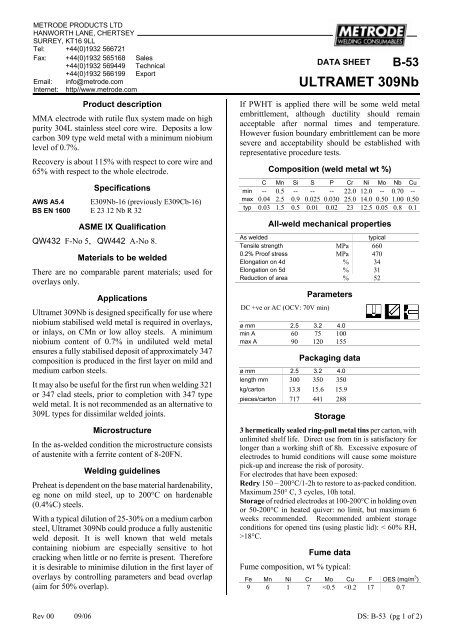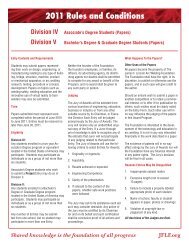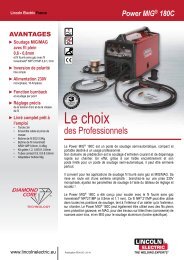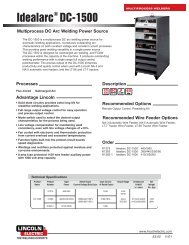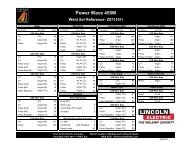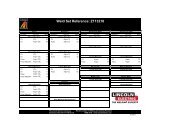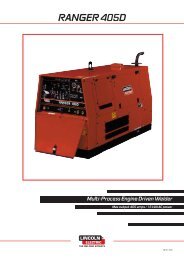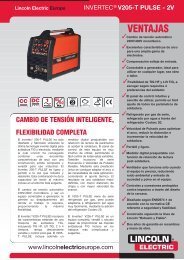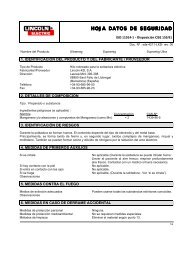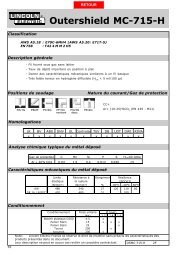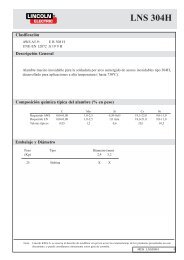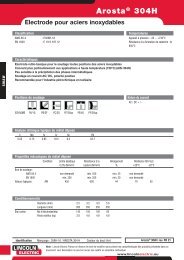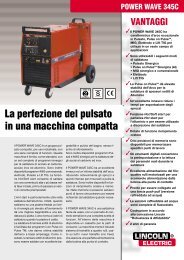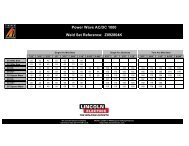Metrode Consumables Catalog
Metrode Consumables Catalog
Metrode Consumables Catalog
Create successful ePaper yourself
Turn your PDF publications into a flip-book with our unique Google optimized e-Paper software.
METRODE PRODUCTS LTD<br />
HANWORTH LANE, CHERTSEY<br />
SURREY, KT16 9LL<br />
Tel: +44(0)1932 566721<br />
Fax: +44(0)1932 565168 Sales<br />
+44(0)1932 569449 Technical DATA SHEET B-53<br />
+44(0)1932 566199 Export<br />
Email: info@metrode.com<br />
Internet: http//www.metrode.com ULTRAMET 309Nb<br />
Product description<br />
MMA electrode with rutile flux system made on high<br />
purity 304L stainless steel core wire. Deposits a low<br />
carbon 309 type weld metal with a minimum niobium<br />
level of 0.7%.<br />
Recovery is about 115% with respect to core wire and<br />
65% with respect to the whole electrode.<br />
AWS A5.4<br />
Specifications<br />
E309Nb-16 (previously E309Cb-16)<br />
BS EN 1600 E 23 12 Nb R 32<br />
ASME IX Qualification<br />
QW432 F-No 5, QW442 A-No 8.<br />
Materials to be welded<br />
There are no comparable parent materials; used for<br />
overlays only.<br />
Applications<br />
Ultramet 309Nb is designed specifically for use where<br />
niobium stabilised weld metal is required in overlays,<br />
or inlays, on CMn or low alloy steels. A minimum<br />
niobium content of 0.7% in undiluted weld metal<br />
ensures a fully stabilised deposit of approximately 347<br />
composition is produced in the first layer on mild and<br />
medium carbon steels.<br />
It may also be useful for the first run when welding 321<br />
or 347 clad steels, prior to completion with 347 type<br />
weld metal. It is not recommended as an alternative to<br />
309L types for dissimilar welded joints.<br />
Microstructure<br />
In the as-welded condition the microstructure consists<br />
of austenite with a ferrite content of 8-20FN.<br />
Welding guidelines<br />
Preheat is dependent on the base material hardenability,<br />
eg none on mild steel, up to 200°C on hardenable<br />
(0.4%C) steels.<br />
With a typical dilution of 25-30% on a medium carbon<br />
steel, Ultramet 309Nb could produce a fully austenitic<br />
weld deposit. It is well known that weld metals<br />
containing niobium are especially sensitive to hot<br />
cracking when little or no ferrite is present. Therefore<br />
it is desirable to minimise dilution in the first layer of<br />
overlays by controlling parameters and bead overlap<br />
(aim for 50% overlap).<br />
If PWHT is applied there will be some weld metal<br />
embrittlement, although ductility should remain<br />
acceptable after normal times and temperature.<br />
However fusion boundary embrittlement can be more<br />
severe and acceptability should be established with<br />
representative procedure tests.<br />
Composition (weld metal wt %)<br />
C Mn Si S P Cr Ni Mo Nb Cu<br />
min -- 0.5 -- -- -- 22.0 12.0 -- 0.70 --<br />
max 0.04 2.5 0.9 0.025 0.030 25.0 14.0 0.50 1.00 0.50<br />
typ 0.03 1.5 0.5 0.01 0.02 23 12.5 0.05 0.8 0.1<br />
All-weld mechanical properties<br />
As welded typical<br />
Tensile strength MPa 660<br />
0.2% Proof stress MPa 470<br />
Elongation on 4d % 34<br />
Elongation on 5d % 31<br />
Reduction of area % 52<br />
DC +ve or AC (OCV: 70V min)<br />
Parameters<br />
ø mm 2.5 3.2 4.0<br />
min A 60 75 100<br />
max A 90 120 155<br />
Packaging data<br />
ø mm 2.5 3.2 4.0<br />
length mm 300 350 350<br />
kg/carton 13.8 15.6 15.9<br />
pieces/carton 717 441 288<br />
Storage<br />
3 hermetically sealed ring-pull metal tins per carton, with<br />
unlimited shelf life. Direct use from tin is satisfactory for<br />
longer than a working shift of 8h. Excessive exposure of<br />
electrodes to humid conditions will cause some moisture<br />
pick-up and increase the risk of porosity.<br />
For electrodes that have been exposed:<br />
Redry 150 – 200°C/1-2h to restore to as-packed condition.<br />
Maximum 250° C, 3 cycles, 10h total.<br />
Storage of redried electrodes at 100-200°C in holding oven<br />
or 50-200°C in heated quiver: no limit, but maximum 6<br />
weeks recommended. Recommended ambient storage<br />
conditions for opened tins (using plastic lid): < 60% RH,<br />
>18°C.<br />
Fume data<br />
Fume composition, wt % typical:<br />
Fe Mn Ni Cr Mo Cu F OES (mg/m 3 )<br />
9 6 1 7


